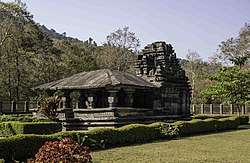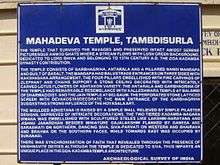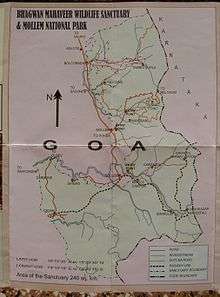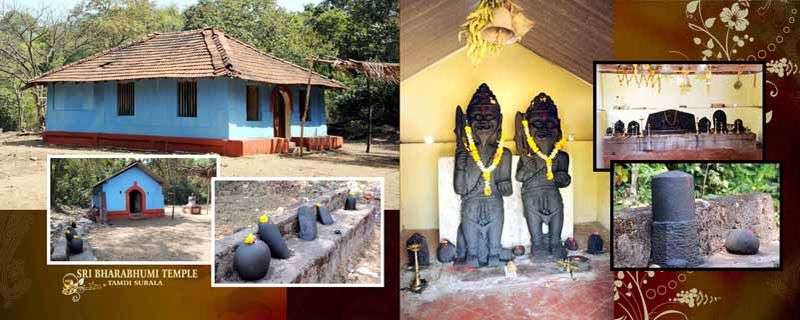Mahadev Temple, Tambdi Surla
Mahadeva Temple, Tambdi Surla is a 12th-century Shaivite temple dedicated to Lord Shiva and an active place of Hindu worship. It is the only structural temple of the Kadamba period to survive the destructive violence of religious intolerance during Muslim and Portuguese occupations of Goan territory.[1]
| Mahadev Temple | |
|---|---|
 Shri Mahadev Temple, Tambdi Surla, Goa | |
| Religion | |
| Affiliation | Hinduism |
| Deity | Mahadeva (Shiva) |
| Location | |
| Location | Tambdi Surla, Goa |
| Country | India |
| Architecture | |
| Style | Kadamba |
| Date established | 12th century CE |
History

The temple is built in the Kadamba style from basalt, carried across the mountains from the Deccan plateau and carved by craftsmen. It is considered to be the only specimen of Kadamba architecture in basalt stone preserved and available in Goa. The temple survived invasions and the Goa Inquisition due to its remote location in a clearing deep in the forest at the foot of the Western Ghats which surround the site.
Tambdi Surla
Religious significance and decoration
The temple is dedicated to Lord Shiva and is reminiscent of the temples at Aihole in neighbouring Karnataka. There is a linga (symbol of Lord Shiva) mounted on a pedestal inside the inner sanctum, and local legend has it that a huge king cobra is in permanent residence in the dimly lit interior.
The temple consists of garbhagriha, antarala and a pillared Nandi mandapa built of basalt. The four pillars, embellished with intricate carvings of elephants and chains support a stone ceiling decorated with finely carved Ashtoken lotus flowers.[2][3]
The intricate carvings created by skilled craftsmen adorn the interior and the sides of the building. Bas-relief figures of Lord Shiva, Lord Vishnu and Lord Brahma, with their respective consorts appear on panels at the sides of the temple. Unusually, the mandap (pillared hall) is covered with a roof of plain grey sloping slabs. The temple faces east so that the first rays of the rising sun shine on the deity. There is a small mandap and the inner sanctum is surmounted by a three-tired tower whose top is incomplete or has been dismantled sometime in the distant past.
There is a headless Nandi (bull, Shiva's vehicle) in the centre of the mandap, surrounded by four matching columns. The symbol of the Kadamba kingdom, an elephant trampling a horse is carved on the base of one of the columns. The river Ragado, (via village Keri, Sattari) flows nearby and is reachable for ritual bathing by a flight of stone steps.
The festival of Mahashivratri is celebrated with pomp and gaiety at the temple by local people residing in surrounding villages. The temple is built in a place which is quite inaccessible and away from the main settlements of the time. The temple is small compared to the average Goan temple.
Location

The temple is at 15°26′20″N 74°15′8″E near a small village called Tambdi Surla located 13 kilometres (8.1 mi) east of Bolcornem village, in the north east region of the Bhagwan Mahaveer Sanctuary and Mollem National Park. Nearby village is Molem.
Mahadev Temple is approximately 65 kilometres (40 mi) from the capital city of Panaji. It is accessible from the north via minor roads 22 kilometres (14 mi) south from the main town of Valpoi in Sattari Taluka. The temple is at the foot of the Anmod Ghat, which connects Goa to the state of Karnataka.
Gallery
- Mahadev Temple, Tambdi Surla, Goa
 View from Outside
View from Outside The Lingam
The Lingam HDR image of carvings on the ceiling of Mahadev Temple.
HDR image of carvings on the ceiling of Mahadev Temple. Intricate King Cobra Rock Carvings
Intricate King Cobra Rock Carvings Carvings Inside Mahadev Temple
Carvings Inside Mahadev Temple Visitors Relaxing
Visitors Relaxing Rear of the temple
Rear of the temple Carved stone pillars forming Mukhamantapa
Carved stone pillars forming Mukhamantapa
- Bharabhumi Temple, Tambdi Surla, Goa
 Bharabhumi Temple, Tambdi Surla, Goa
Bharabhumi Temple, Tambdi Surla, Goa
References
| Wikimedia Commons has media related to Mahadev Temple, Tambdi Surla. |
- Hall, Maurice (1995). Window on Goa: A History and Guide. Quiller. p. 214. ISBN 9781870948982.
- Archaeological Survey of India, sign at location
- Mahadev Temple, Tambdi Surla Archived 2009-01-07 at the Wayback Machine
